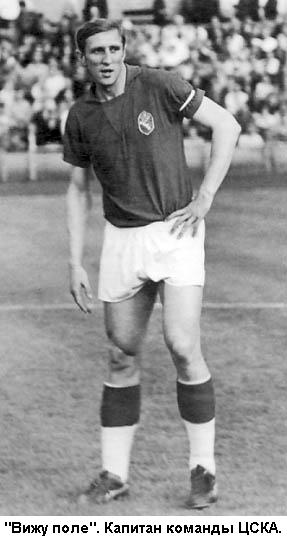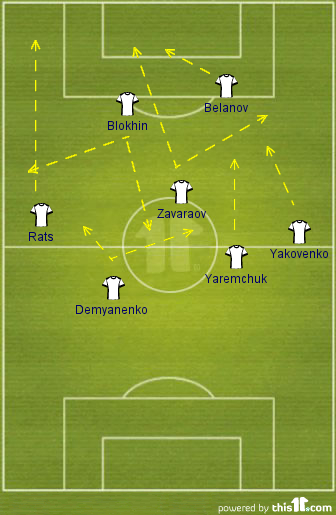

@Raees ______________________________________________________ @Gio @Theon
The draft thread with lots of additional information
Write-ups on specific players
Raees
TACTICAL BLUEPRINT
4-2-3-1 built on the best defence in the draft, an all conquering midfield which contains 2 Ballon D'or winners (and the world's best midfielder of the 20's) and the lethal trio of Làszlô Kubala (Voted Barcelona's greatest player of the century) the electric dynamo who was seen as the equal of Di Stefano during the late 50's, Ferenc Puskàs (top 7 player of all time and the best player in this draft) and enigmatic, complete forward 'Gundi' Asparuhov up top (voted Bulgaria's all time best player ahead of Stoichkov).
DEFENSIVE STRATEGY
1. 'IVAN THE TERRIBLE' VS 'GOLDEN HEAD'
- Kocsis was not a tall battering ram of a centre-forward like a Nordahl or a Vieri but actually 5ft 9 and a nippy, agile, technically complete centre forward who happened to be majestic in the air. With his scoring record, you can't guarantee you'll keep him quiet but if anyone is best suited to pulling off this task it has to be Albert Shesternyov (with the safety net of none other than the legendary best defender in Eastern European history Velibor Vasović) who will stay touch-tight to Kocsis and be very aggressive in ensuring he doesn't get time and space in the box, forcing him to operate deeper with his back to goal.
- Shesternyov was an ideal candidate in trying to mark a 'complete' centre-forward. Mixture of sweeper/stopper.. he can deal with quick twists, turns, battle with them in the air and had a great defensive feel for the game. Considered one of the fastest defenders in history,, strong, agile.. sort of like a 60s equivalent of Pietro Vierchowod. He came to fame by marking Gianni Rivera out of the game in a qualifier in 1963 (Proving his ability to deal with silky attackers as well as powerhouses), and helped Russia to 1964 Euro Final, 1966 World Cup semi final, 1968 semi finals, and 1970 WC QF's. As a defender he was selected in Ballon D’or rating 4 times, getting the best rating of 10th.
- Having scouted Gio's attack, have to agree with Harms assessment that if anything Blokhin is a bigger threat than Stoichkov, purely because he's bit more unpredictable and has better footwork. One thing that will be thrown at me is that compared to his side, I lack traditional width but having studied Blokhin close up.. whilst he could make runs out wide like we saw against Bayern, he was actually more of a free role attacker who played more as a second striker. He would drift wide onto either flank to cause damage but predominantly he needed to be central to be effective.. the same goes for Stoichkov, who could cross the ball rather well but in reality, he wanted to come in off the flank and get in between the lines and score goals.
- Therefore Gio's attack is potentially more narrow than he would care to admit despite their ability to use their pace to go round the outside, which could make it more easier for me to defend as I feel my attack is better in tighter spaces whereas his attack needs space in which to run into otherwise they could get frustrated. With Stanković tucking in, almost challenging Blokhin to go round the outside.. the goal threat we face from that flank is reduced, as Blokhin doesn't really want to be whipping balls in, he isn't that type of player. Likewise with Stoichkov down the right, if Demyanenko forces him down the line all the time, it will reduce his threat because his right foot is considerably weaker than the right. Of course Gio might try to surprise me and play them on opposite wings, in which case the principle remains the same although we will need to be vigilant and ensure Stoichkov isn't given free reign to cross the ball.
- Imagine Cristiano being reduced into a Beckhamesque winger, he'd get frustrated at having to be a support act. Ideally Gio would want a Czibor/Dzajic hugging the touchline, which would give more space on the other flank to a wide forward coming in off the flank like Blokhin or Stoichkov. Both of them in the same side, is like having two Cristiano type wingers and against a well drilled defence, there could be potential question marks on the subtlety about that wide threat.
- After seeing off Hagi and Stojkovic, 'Kada' comes face to face with another gifted 10 in Sekurlac. Sekurlac was a showman, crowds adored him for his dribbling ability but he was called self-obsessed and not a team player. Criticisms also involved him going AWOL, if he didn't feel like he was the star of the show. In a heated match like this and against one of the toughest DM's in the draft.. I think there are big question marks over his mental ability to influence proceedings.
- Santiago Bernabeu once stated that Pele, Di Stefano and Kada were the three best players he had ever seen.. now when you consider he was a defensive mid, one would have to conclude there are not many midfielders out there who would be better equipped to take on Sekurlac. Kada had bags of endurance, renowned for his astute reading of the game, peace of mind under pressure and immaculate tackling.. he had faced up to the likes of Sindelar in the mid to late 20's and came up trumps. Just to illustrate his influence, when the Czechs were the best nation in europe during the 1920's, his sheer presence ensured they won some big games:
- CZE 6-1 YUG (KADA captain) 1921 vs CZE 3-4 YUG (KADA DNP) 1922
- CZE 5-1 ITA (KADA captain)1923 vs CZE 1-1 ITA (KADA DNP) 1922
- CZE 2-1 AUSTRIA (KADA captain) 1926 vs CZE 1-2 AUSTRIA (KADA DNP) 1926
- The other issue Gio faces is, Stoichkov and Blokhin are not really elite level 'playmakers'.. they can't contribute to the build up as much as Kubala and Puskàs, so if Sekurlac is shackled, and Voronin is trying to focus on his defensive duties (tracking Masopust or Albert).. there is no one in his side who can focus on effectively controlling the tempo.
ATTACKING STRATEGY
1. KUBALA THE 'ALL-ACTION' DYNAMO AND RECREATING THE PUSKÀS/HIDEGKUTI DYNAMIC
- Thanks to Joga and Enigma, I went from being quite flummoxed by Kubala to falling in love with him once I watched more full games of him. The most interesting thing about him apart from his brilliantly physical yet elastic style of dribbling with the ball, with its jinky step overs and ferocious body swerves was his tactical brain and work-rate. In the games I watched, he was like a Boniek type player in one sense in that he would get back and take up good positions defensively, but what separates him is his agility going forwards.. he was very unpredictable with his trickery and he could score himself (217 goals in 327 games) or put in world-class crosses, as Mr Kocsis will testify. The battle against Lovchev who is athletically gifted, will be one that Kubala will relish..they're evenly matched on that front but in all fairness, there is a class deficit in this battle. Kubala is simply one of the greatest footballers of all time, and Lovchev will surely have question marks over his head regarding whether he'll be able to anticipate what Kubala throws at him.
- If Albert and Puskàs had played together in 1960, or even at World Cup 1958.. Hungary would surely have put to bed the miracle of Berne from 1954. It would have rekindled memories of Puskas' love affair with Hidegkuti but in all fairness to the false 9 maestro, Albert was even more of a match winner and someone who could carry a side of his own back not just facilitate other great players. If you watch that memorable Albert performance v Brazil, you see a attacking midfielder who can drift to both flanks and wreak havoc.. which is very important in giving my side some penetration and pace out wide, especially if Puskas cuts in. Puskas is playing in his 1954 role and looking to wreak havoc with his dribbling, majestic footwork and utilise his next dimensional finishing/through passing ability. He will also seek to ping balls onto to Asparuhov's head if slotting him through doesn't work.
- In a game this tight, where the teams are pretty even.. controlling particular zones of the pitch will be crucial. Win enough key battles and you will eventually win the war. One side of the pitch where I am hoping to dominate is the left flank. On my left flank, I have Puskas, Masopust and Demyanenko.. He has Stoichkov and Bezonov. Of course his mids can come out wide to join the battle, but they won't be effective going forwards down the flanks.. I have three players who can all interplay down the left and Gio will find it very hard to stop my side from building up play down that flank time and time again. He can frustrate me down that flank, but he can't build up down that flank like I can.
- Even on the other flank, you could argue that Kubala and Stankovic is an outstanding right wing pairing, full of class going forwards and robust defensively, with higher tier tactical intelligence and edges Blokhin/Lovchev down that side as a pairing. His combinations on either flank are packer, granted but in terms of tactical astuteness and quality in possession, on both flanks my side is more measured with the ball and off it.
- Due to the threat of my attack, I can't envisage him letting his full-backs bomb on all that much, in all fairness I am in a similar boat. Just to make it clear, Kubala was terrific at tracking back out wide in the 1961 EC final, a real work-horse considering he was meant to be a virtuoso type talent, will track back Lovchev and Masopust will track Bezsonev... Voronin isn't really a goal-threat, so I don't need to worry too much about him bombing forward, he'll be more concerned with helping Pluskal out against Albert.
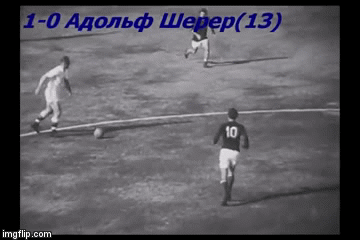
As his Hungarian teammate Jeno Buzansky put it, "If a good player has the ball, he should have the vision to spot three options... Puskas always saw at least five." Raymond Kopa once remarked that goalkeepers were terrified of Puskas, even if the Hungarian striker was 35 meters away from goal. His shot was stinging and precise. He is considered to have the best shot of all time in terms of accuracy and that is just one minor facet of what made him one of the greatest footballers of all time. He scored in every game he played in the 1954 World Cup, including the opening goal in the world cup final (With a hairline fracture).
If the Ballon D'or existed from post war onwards, I think it is fair to say from 1948-54.. he was the best player in the world and probably would have had at the very least 3-4 Ballon D'ors. No one on the pitch comes close to that sort of pedigree.
I think it is fair to say he was the Messi of the late 40-early 50's.. velcro like first touch, insane passing ability (outside of the foot passes, scoop passes, crossing using all parts of the foot, slide through passes, reverse passes), superb close control when running with the ball, quick feet, the ability to control a game with clever movement, integrating team-mates and god-like finishing ability. Below are some clips, from the game v England in 1953.
ASSIST TO HIDEGKUTI (LEFT INSIDE FORWARD POSITION)
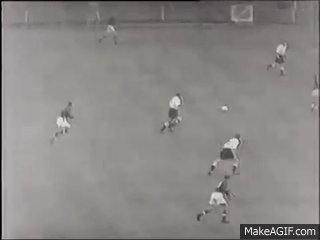
BECKHAMESQUE CROSS TO HIDEGKUTI
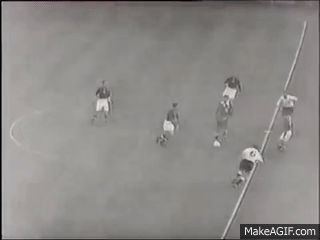
THE LEGENDARY PUSKAS V TURN

DRIFTS TO RIGHT FLANK (HITS OUTSIDE OF FOOT THROUGH BALL)
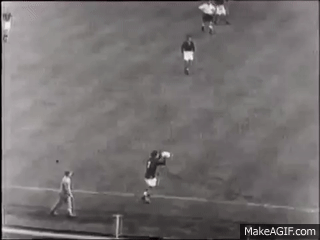
CLEVER HOLD UP PLAY

PERFECTLY WEIGHTED THROUGH BALL

SKIPS PAST A MAN BY CUTTING IN FROM LEFT AND RELEASES BEAUTIFUL PASS
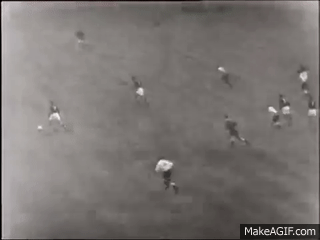
SLALOMING DOWN THE LEFT
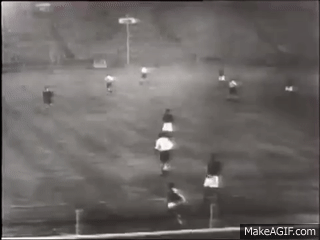
MAGICAL FIRST TOUCH FOLLOWED BY STUNNING DIAGONAL OUTSIDE OF FOOT PASS
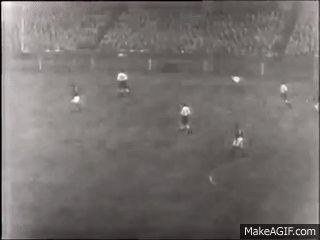
LEAVING FULL BACK FOR DEAD DOWN LEFT FLANK
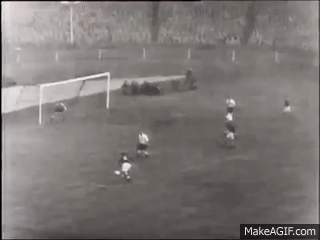
BEATING PLAYERS WITH HIS FIRST TOUCH
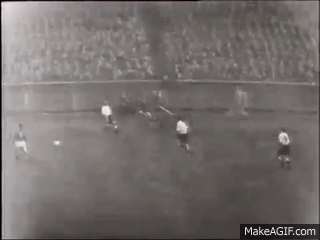
If the Ballon D'or existed from post war onwards, I think it is fair to say from 1948-54.. he was the best player in the world and probably would have had at the very least 3-4 Ballon D'ors. No one on the pitch comes close to that sort of pedigree.
I think it is fair to say he was the Messi of the late 40-early 50's.. velcro like first touch, insane passing ability (outside of the foot passes, scoop passes, crossing using all parts of the foot, slide through passes, reverse passes), superb close control when running with the ball, quick feet, the ability to control a game with clever movement, integrating team-mates and god-like finishing ability. Below are some clips, from the game v England in 1953.
ASSIST TO HIDEGKUTI (LEFT INSIDE FORWARD POSITION)

BECKHAMESQUE CROSS TO HIDEGKUTI

THE LEGENDARY PUSKAS V TURN

DRIFTS TO RIGHT FLANK (HITS OUTSIDE OF FOOT THROUGH BALL)

CLEVER HOLD UP PLAY

PERFECTLY WEIGHTED THROUGH BALL

SKIPS PAST A MAN BY CUTTING IN FROM LEFT AND RELEASES BEAUTIFUL PASS

SLALOMING DOWN THE LEFT

MAGICAL FIRST TOUCH FOLLOWED BY STUNNING DIAGONAL OUTSIDE OF FOOT PASS

LEAVING FULL BACK FOR DEAD DOWN LEFT FLANK

BEATING PLAYERS WITH HIS FIRST TOUCH

Gio (Theon)
TACTICS:
We set up in a rock-solid 4-3-3 formation defined by searing pace out wide and a blend of steel and class through the spine. Two of the strongest full-backs in the pool, Vladimir Bezsonov and Evgeny Lovchev, man the flanks and will be expected to defend narrowly in the absence of any genuine wide threats. The central defensive unit is led by the great Khurtsilava whose world-class reading, anticipation and positioning will be vital in dealing with the centrally-orientated threats posed by Puskas and Kubala. Next to the elite sweeper/covering centre back we have the perfect complimentary partner in the physical West German stopper 'the Bull' Wolfgang Weber whose athleticism and dynamism makes him one of the standout stoppers in the pool and helps to square directly up to Gundi Asparuhov.
The midfield is led by the the peerless Captain Valery Voronin, who will be focused on keeping it tight in the crowded midfield areas and commanding the centre of the park in possession. Completing a solid and intimidating central midfield partnership is Svatopluk Pluskal, arguably the best destroyer in the draft who provides a perfect counter to the very area where Raees is strongest. Our creative influence from midfield is one of the handful of truly special Eastern European #10's in Dragan Sekularac. His exceptional dribbling ability and close control should be too much for Pesek to handle and should provide the attack with a steady stream of service.
On the right of the attack is Barcelona legend Hristo Stoichkov, the 1994 Ballon D'Or winning dynamo who screams goals and penetration. The point of the attack is the finest #9 in the pool Sandor Kocsis (75 goals in 68 games internationally). The final piece of the jigsaw is the greatest USSR footballer of them all, 1975 Ballon D'Or winner Oleg Blokhin, the left-sided flying machine whose lightning pace is a constant threat on the counter and who is well places to create opportunities from the left when Stankovic pushes forward in Raees's narrow set-up.
WHY WE WILL WIN:
- We have strengths to counter where Raees's quality lies - The opposition is likely to line up with three support strikers all jostling for the same space in the hole, the very space occupied by the formidable Voronin and Pluskal. We all know Voronin's qualities but even more important in countering this central threat will be the imposing and defensively ruthless Pluskal. In our view Pluskal is the best man in the draft for such a destructive job in front of the defence. He was the keystone behind the two-man midfield, liberating Masopust, that propelled Czechoslovakia to become the first European team to reach a World Cup final outside of the continent.
- Building on the above the lack of attacking width for Raees will allow our full-backs to defend narrowly, squeezing the space available to throttle the forwards in the middle. On the other side, our world class wide-men will stretch Raees' defence and create gaps for Kocsis centrally - most importantly the presence of Stoichkov-Blokhin will create problems whenever Raees's fullbacks push forward, both forwards were lightening quick, wonderful dribblers and elite level goalthreats who are absolutely devastating on the counter.
- As much as it was clear that Pesek was one of the foremost midfielders in the early 1900s, as a man who was playing professionally in 1913, the guile and speed of thought of Sekularac is likely to give him an uncomfortable time.
- Ultimately we believe that we have the more balanced team and complimentary attack - Blokhin and Stoichkov flanking Kocsis is a barnstorming, fluid and penetrating front three which comprises two Ballon D'Or winners and one of the greatest goalscorers of all time. The pace of the wide men makes them devastating on the counter, whilst the movement, technique and predatory instincts of Kocsis provide a focal point for more patient build-up.




